You can compare Olive Oil with wine. Its quality and taste is influenced by geographical factors such as soil and region, similar to the terroir in Bordeaux. 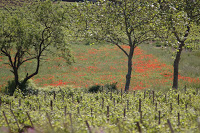 You also have good and bad olive years, depending on the weather during a certain season.
You also have good and bad olive years, depending on the weather during a certain season.
The quality depends much on the care of the growers and producers. There are oils with a strong taste and some with a delicate one. Some are spicy and others have a grassy or nutty flavour. They come in different colours, yellow or green and this is to do with the time of harvest, not the quality. The Olive itself ranges from green (unripe) through red to black (ripe).
They are often cultivated alongside the arid grape growing regions and are themselves a natural finger food when paired with a glass of wine. A pure Sauvignon Blanc wine, such as Montagnac Sauvignon Blanc (£4.75), or Chateau Saint Thibeaud (£5.30) would be nice. My preference however, would be chilled white port as some olives can be too piquant for many wines.
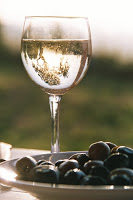 You may ask why I am waxing lyrical about Olives. Britain is now growing them commercially thanks to global warming. The first British olive grove was planted in 2006 in a smallholding in Devon on the banks of the River Otter.
You may ask why I am waxing lyrical about Olives. Britain is now growing them commercially thanks to global warming. The first British olive grove was planted in 2006 in a smallholding in Devon on the banks of the River Otter.
They were sourced from Tuscany which has frost and snow in Winter as well as baking temperatures in the Summer, so they should be pretty tough. Already, the UK growing season has lengthened by about a month since 1900.
By mid-century, maximum temperatures in southern counties could break through the 40C (104F) level, and by 2080, the South East could be as hot as Bordeaux is now.
Mark Diacono has established a “climate change farm” on his land and also grows almonds and apricots. Mr Diacono feels that if we could produce crops that at present involve many “food miles” to be brought to Britain we could help combat climate change as well as take advantage of it. As McCarthy says:
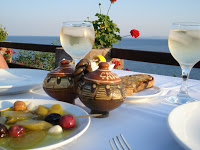 “Several studies have suggested that in decades to come olives, vines and other warm climate plants will be likely to flourish in a substantially warmer Britain.”
“Several studies have suggested that in decades to come olives, vines and other warm climate plants will be likely to flourish in a substantially warmer Britain.”
Two commercial olive groves have been planted much further north, in Wales and Shropshire. Three hundred Italian olive trees were planted at Wroxeter Roman Vineyard, near Shrewsbury, and the first Welsh olive grove was begun in Anglesey.
The Olive (Olea Europaea) is native to the coastal areas of the Eastern Mediterranean, stretching from Syria and maritime parts of Asia Minor and Northern Iran at the end of the Caspian Sea. It has a preference for calcareous soils, flourishing best on limestone slopes and crags and in coastal climate regions.
 Ancient agriculturalists believed that the Olive would not succeed if planted more than a short distance from the sea. Modern experience does not always confirm this and though showing a preference for the coast, Olives have been grown further inland where there is a suitable climate such as Australia, New Zealand and California.
Ancient agriculturalists believed that the Olive would not succeed if planted more than a short distance from the sea. Modern experience does not always confirm this and though showing a preference for the coast, Olives have been grown further inland where there is a suitable climate such as Australia, New Zealand and California.
I remember the Olives growing on the slopes of a once fertile valley in Tunisia when walking round the parched and dusty remains of a Roman town set high on the escarpment. The little trees had immense girth and were gnarled and twisted.
They had been planted in lines by the Romans living there and had survived when most else had failed. Pliny the Elder once told of an Olive tree that was 1600 years old and some claim the Olives in the garden of Gethsemane date back to the time of Christ.
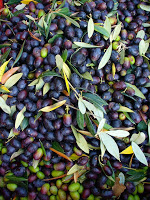 The calming and healing properties of Olive Oil have been recognised for millennia. The Olive branch has long been the symbol for peace and the phrase “pouring oil on troubled waters” refers to this as well. In the Bible the dove brought back an Olive branch as the first vegetation seen by Noah after the deluge.
The calming and healing properties of Olive Oil have been recognised for millennia. The Olive branch has long been the symbol for peace and the phrase “pouring oil on troubled waters” refers to this as well. In the Bible the dove brought back an Olive branch as the first vegetation seen by Noah after the deluge.
Traditionally the Olive fruit is blessed since Jesus’ tear fell on one while praying on Mount Olivet. Medicinally Olives are astringent and antiseptic. The oil can be used to treat burns and stings and has a positive effect on our cholesterol levels. Fenol like substances play a role in the prevention and cure of thrombosis and arteriosclerosis.
Of course Olives can be cured in brine or lye and eaten, stuffed with pickled pimento, onion, almonds, anchovies, jalapenos, capers or garlic. It may not be BBQing weather at the moment but this is a fantastic recipe and you can make it indoors! At least it captures the last of the summer in its flavours!
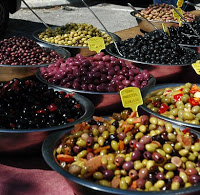 Lamb Kebabs with Pomegranate Marinade and Black Olive and Anchovy Sauce
Lamb Kebabs with Pomegranate Marinade and Black Olive and Anchovy Sauce
There are two marinades to baste the Lamb Kebabs in:
2 lbs boneless Lamb Shoulder, cut into cubes
Use half of the Lamb cubes with:
Pomegranate Marinade
½ cup Pomegranate Juice
1/3 cup Olive Oil
1 tbsp Lemon Juice
2 cloves Garlic, crushed
2 tbsp Green Olives, crushed
salt & pepper
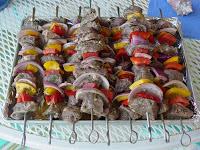 Crush the Garlic, Green Olives, Salt and Pepper into a paste in a pestle and mortar. Mix with Pomegranate, Olive Oil and Lemon Juice in plastic bag. Add half the Lamb cubes and squeeze the air out. Toss to cover and refrigerate over night. Thread lamb onto skewers and baste whilst BBQing with any remaining marinade.
Crush the Garlic, Green Olives, Salt and Pepper into a paste in a pestle and mortar. Mix with Pomegranate, Olive Oil and Lemon Juice in plastic bag. Add half the Lamb cubes and squeeze the air out. Toss to cover and refrigerate over night. Thread lamb onto skewers and baste whilst BBQing with any remaining marinade.
Use the other half of the Lamb cubes with:
Black Olive and Anchovy Sauce
2 tbsp Olive Oil
large pinch of Thyme
large pinch of Rosemary
1 tsp Garlic
1 tbsp Butter
½ cup White Wine
1 cup Lamb Stock (use a cube)
¼ cup Tomato Puree
2 tbsp Black Olives, crushed
1 tbsp Anchovies, crushed
salt & pepper
Rub the Lamb cubes with the Olive Oil and BBQ on skewers. Crush the Rosemary, Thyme, Black Olives, Anchovies, Salt and Pepper in a pestle and mortar to make a paste. Saute the Garlic in the butter, add the White Wine, Tomato Puree and Lamb Stock to this and reduce. Add the paste. Rub the Lamb cubes with the Olive Oil and BBQ on skewers. Serve the sauce warm as a dip to dunk the Lamb Kebabs in.
Images Courtesy of www.flickr.com

